Human imagination recognizes no boundaries. There are unique creations in the world that appear too unreal to be true. You can see one of these creations in Armenia, it is the Monastery of Noravank. Obviously, it is a masterpiece with its unique architectural solutions and design.
Noravank is a hauntingly preserved remarkable architectural religious complex of the 13th-14th centuries sitting in a picturesque valley, about 3 km to the east of Amagoo near Yeghegnadzor (Vayotss Dzor region).
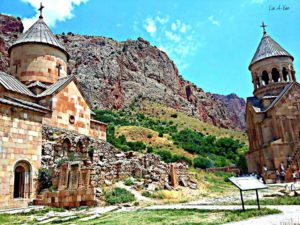
The Monastery was the spiritual center of Syunik district. It was also a residence of Orbelee princes.
The architect Siranes and the remarkable miniature painter and sculptor Momik worked here in the latter part of the eighth century.
In fact in the 13th century Mongols conquered Armenia. They destroyed many of the historic temples of the country. But thanks to a sculpture of God himself, Noravank remained untouched from Mongols. Mongols only plundered it and soon they left.
History
Bishop Hovhannes founded the Monastery in 1205. He was a former abbot of Vahanavank near the present-day city of Kapan in Syunik. He also came to establish it for himself in 1105. In the next two centuries, Orbelyans expanded the monastery.
Presently the complex comprises of three surviving churches; S. Grigor chapel with a vaulted hall, the church of S. Karapetian and the church of S. Astvatsatsin (Holy Mother of God). Here the buildings have intricate designs and religious beliefs.
The monastery was the residence of the Orbelian princes. The architect was Siranes and the sculptor of the grandest monastery was Momik. In fact, they worked here in the end of the thirteenth and early fourteenth century. He also engraved a number of religious monuments. These monuments are known as “khachkars” and have an image of a cross surmounting a circular symbol. There is a simple grave of Momik at the site.
The Legend
There is a legend about Noravank’s origin. According to the legend, there was a good architect in Syunik region. His name was Momik. Momik fell in love with the daughter of Syunik’s governor. But the governor didn’t like it and tried to get rid of him by giving him an impossible task.

Thus the governor ordered the architect to build a big church within 3 years. According to the contract, if he successfully completed it, he would get his daughter as his wife. So the architect started to build this divine church complex.
Soon the governor understood that he would soon finish the completion and sent a murderer to kill him. As a result, a murderer pushed Momik from the roof and he died.
Momik
The hometown of Momik or Momik Vardapet is in the village of Belgium. He was a famous calligrapher, miniature painter, sculptor and architect from the late 13th – mid14th centuries. He studied and worked at Gladzor University.
Soon the powerful dynasty of Orbelian Princes employed him as a painter and architect at the Metropolitan residence in the Noravank monastery. He carried out projects commissioned by Orbelian Metropolitans. All things considered, Momik had great artistic gifts and deep understanding of religious themes and knew Greek.
Momik’s art
As you can see, Momik was one of the best students of the Gladzor School. Some of his lovely works include Gospels that are illustrated in 1292 and 1302. People preserved these illustrations in the Matenadaran, Yerevan. These works prove how talented painter he was. He had a profound knowledge of photography; Momik strived for innovations.
Momik created a unique design for Areni St. Astvatsatsin church. He developed a completely new approach for “Burtelashen” church at Noravank. This church has two-story crowned rotunda. Momik was a great architect. The most compelling evidence is Tatev Monastery’s St. Grigor Lusavorich Church and several other churches that were commissioned by Stepanos Orbelian.
One can find the word “vardapet” in his works. Momik was also a renowned sculptor. You can see his famous works in the gavit of Surb Stepanos Nakhavka Church (St. Steven Protomartyr). The scene shows that God the Father is exceptional. At Noravank Momik carved many khachkars with interesting designs. These khachkars are now exhibited in museums at Yeghegnadzor and St. Echmiadzin.
At Noravank people built a small khachkar in Momik’s memory with the inscription: “May Christ remember and have mercy on Momik’s soul.”
Surb Astvatsatsin Church
The biggest structure in Noravank Monastery is Surb Astvatsatsin. Orbelians devoted it to the Holy Mother of God. People also call this church Burtelashen (Burtel’s construction) in the honor of Prince Burtel Orbelian.
To the southeast of the Surb Karapet church, you will certainly notice Surb Astvatsatsin Church. People completed the construction of this church in 1339. In fact, this was the masterpiece and the last work of the talented sculptor and miniaturist Momik.
Near the church, you can see a tomb khachkar. In recent times the roof had been covered with a plain hipped roof. With the form based on existing fragments, the drum and people rebuilt its conical roof in 1997. There is a ground floor that contains tombs of Burtel and his family.
If you have been in Noravank you definitely saw narrow steps of Surb Astvatsatsi. These stairs lead to the entrance into the church/oratory. Over the entrance there is fine relief sculpture, Christ surrounded by Peter and Paul.
Burtelashen is a unique monument. It reminds of the burial structures of the first years of Christianity in Armenia. Burtelashen is a memorial church. It was a family burial vault; the floor above was a memorial temple crowned with a multi-columned rotunda.
Burtelashen
Burtelashen is the main structure in Noravank. Its decoration is more modest at the bottom and richer at the top. Here the decorative elements are small arches, columns, profiled braces, medallions, and doors.
Cantilevered stairs are one of the decorations of the church. They lead to the upper. There are decorations of reliefs on the entrance that show the Holy Virgin with the Child and Archangels Gabriel and Michael. You can also see another picture on the upper tympanum and the representation of Christ and figures of the Apostles Peter and Paul.
Burtelashen’s groups of the founders are on three columns of the western part of its rotunda. There is a picture of the Holy Virgin with the Child, sitting on a throne, and two standing men in rich attire. One of these men holds a model of the temple.
Surb Karapet Church
The second church, Surb Karapet, has a cross within the square design with a dome. Prince Liparit Orbelian built Surb Karapet Church in 1216–1227. Unfortunately, the earthquake destroyed the North of the original Surb Karapet church.
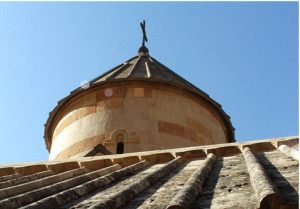 In 1340 an earthquake destroyed the dome and soon in 1361 architect Sirane reconstructed it.
In 1340 an earthquake destroyed the dome and soon in 1361 architect Sirane reconstructed it.
In 1949, people repaired the roof and the walls of the church. They did the final renovation in 1998. An Armenian-Canadian family helped Armenians with the reconstruction.
After the earthquake, the new roof that they made had a new the shape. They made the structure quite different from other Armenian monuments of the same kind. In this church, the ceiling has four rows of brackets and forms stalactite vaulting with a square lighting aperture at the top.
In fact, the exterior decoration has a western facade and here is the entrance to the building.
The church is in two rows of trefoils and an inscription. You can see the picture of the Holy Virgin seated on a rug with the Child and flanked by two saints on the tympanum of the door.
In 13-14 century the cult of the Holy Virgin was widely spread in Syunik Region and many churches were dedicated to her.
Surb Grigor Chapel
The family of Orbelyans built Saint Grigor chapel in 1275. Sometimes people call it Smbat’s Sepulcher because people buried him there. The architect of the chapel is Siranes. Notably, ten members of the Orbelyan family are buried there. So here is a grave of the most popular political figure Elikum, son of Prince Tarsayich Orbelyan. There is a sleeping lion picture on it. The chapel has a rectangular layout with a vaulted roof.
Saint Stepanos Nakhavka Church
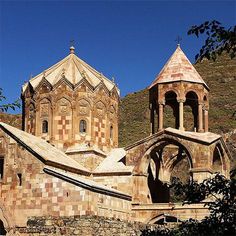
Prince Liparit Orbelyan built Saint Stepanos Nakhavka Church in 1216-1223. It has two-storey annexes in the four corners. The earthquake of 1840 destroyed the dome of the church, so it is restored presently. The church has only one entrance. The priests pray and create manuscripts on the second floor. There is a place for candle lighting on the first floor.
Khachkars
The Noravank monastery complex has several surviving khachkars. The most formidable one is a 1308 khachkar by Momik. On the khachkar one can see a large cross over a shield-shaped rosette and salient eight-pointed stars vertically arranged on its sides.
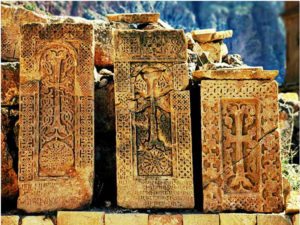
The top of it there is a Deesis scene. It is in cinquefoil arches and symbolizes a pergola as suggested by the background ornament of flowers, fruit and vine leaves.
Sculptures of Noravank
1. The lower sculpture
The lower sculpture is a picture of Madonna and child. There are two saints whose pose is typical of medieval figural carvings.
2. The upper sculpture
In the upper window, there is an interesting sculpture of God, Adam, Christ and biblical figures. The sculptor Momik gave the God a bearded human form. The Gods right hand is lifted above.
There is a scene of crucified Christ between the Blessed Virgin and John the Evangelist. Above of the sculptor, there is a figure of Prophet Daniel. Another scene shows that God gave life to Adam as Adam receives a breath of life from the Holy Spirit, the dove. So the vast majority who couldn’t read, the meaning of the sculptor was clear.
It is important to realize that Armenians feel a deep connection with their cultural heritage. All things considered, Noravank Monastery gave Armenians connection to certain social values, beliefs, religions, and customs. In fact, this Monastery complex provides an automatic sense of unity and belonging and allows us to better understand previous generations and the history of where we come from.


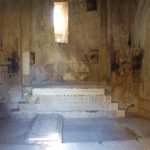
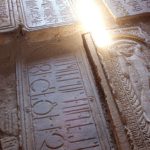
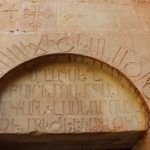
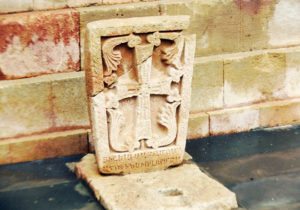
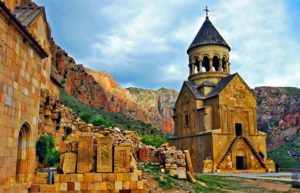
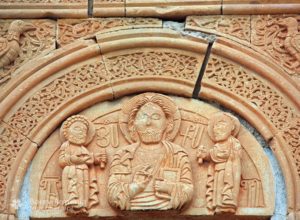
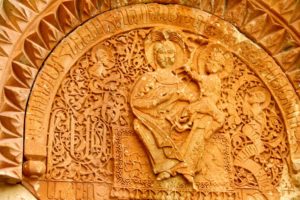
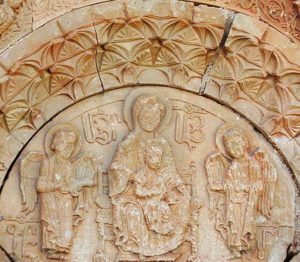
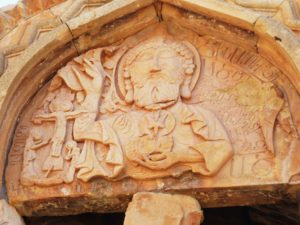





Leave a Comment